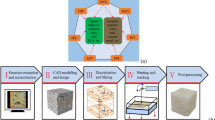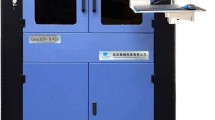Abstract
The presented work compares the mechanical behavior from standard unconfined compressive strength and indirect tensile strength tests of natural sandstone and artificial sand-based specimens created by 3D additive manufacturing. Three natural sandstones of varying strength and stiffness were tested to capture a wide range of behavior for comparison with the 3D-printed specimens. Sand grains with furan and silicate binders, as well as, ceramic beads with silicate binder were 3D-printed by commercial suppliers. The tensile and compressive strength, the stiffness, the crack initiation and the crack damage thresholds and the strain behavior were examined to determine if the mechanical behavior of the 3D-printed specimens is similar to natural sandstones. The Sand-Furan 3D-prints behaved the closest to the weak natural sandstone. The compressive strength-to-stiffness ratio, also known as the modulus ratio, and the compressive-to-tensile strength ratio of the 3D-printed Sand-Furan specimens were found to be similar to the natural sandstones tested in this study and literature values. The failed specimens composed of ceramic beads with silicate binder, both in compression and tension, showed fracture growth not commonly observed in natural specimens. The other 3D-printed specimens generally fractured in a similar manner to natural specimens, although several of the quartz sand with furan binder specimens showed fracturing behavior similar to high porosity natural specimens. Over all, using the commercially available quartz sand with furan binder 3D-print materials showed promise to be able to replicate natural rock specimen behavior.











Similar content being viewed by others
Abbreviations
- D :
-
Specimen diameter (m)
- \({E}_{50}\) :
-
Average Young’s modulus (Pa)
- h :
-
Specimen thickness (m)
- L :
-
Length of scan line along fracture surface (m)
- l :
-
Line segment lengths for correlation functions (m)
- P :
-
Load at primary failure (kg m/s\(^2\))
- \(\epsilon _{y}\) :
-
Maximum vertical strain at failure (–)
- \(\sigma _\mathrm{T}\) :
-
Indirect tensile stress at failure (\(\hbox {kg/m/s}^2\))
- BTS:
-
Brazilian tensile strength
- CC:
-
Crack closure threshold
- CD:
-
Crack damage threshold
- CI:
-
Crack initiation threshold
- ITLS:
-
Inverse Tangent Lateral Stiffness
- LSR:
-
Later strain response
- UCS:
-
Unconfined compressive strength
References
Barton, N., Bandis, S., Bakhtar, K.: Strength, deformation and conductivity coupling of rock joints. Int. J. Rock Mech. Min. Sci. 22(3), 121–140 (1985)
Bieniawski, Z.: Mechanism of brittle fracture of rock, parts i, ii, and iii. Int. J. Rock Mech. Min. Sci. Geomech. Abstr. 4(4), 395–430 (1967)
Blunt, M.J., Bijeljic, B., Dong, H., Gharbi, O., Iglauer, S., Mostaghimi, P., Paluszny, A., Pentland, C.: Pore-scale imaging and modelling. Adv. Water Res. 51, 197–216 (2013)
Bodla, K.K., Garimella, S.V., Murthy, J.Y.: 3D reconstruction and design of porous media from thin sections. Int. J. Heat Mass Transf. 73, 250–264 (2014)
Bourke, M., Viles, H., Nicoli, J., Lyew-Ayee, P., Ghent, R., Holmlund, J.: Innovative applications of laser scanning and rapid prototype printing to rock breakdown experiments. Earth Surface Process. Landf. 33(10), 1614–1621 (2008)
Brown, S.R.: Fluid-flow through rock joints—the effect of surface-roughness. J. Geophys. Res. Solid Earth Planets 92(B2), 1337–1347 (1987)
Deere, D.: Chapter 1: geological considerations. In: Stagg, K.G., Zienkiewicz, O.C. (eds.) Rock Mechanics in Engineering Practice, pp. 1–20. Wiley, New York (1968)
Diederichs, M.S.: Instability of hard rock masses: the role of tensile damage and relaxation. PhD thesis, University of Waterloo, Waterloo (1999)
Diederichs, M.S.: Manuel rocha medal recipient rock fracture and collapse under low confinement conditions. Rock Mech. Rock Eng. 36(5), 339–381 (2003)
Diederichs, M.S.: The 2003 Canadian geotechnical colloquium: mechanistic interpretation and practical application of damage and spalling prediction criteria for deep tunnelling. Can. Geotech. J. 44(9), 1082–1116 (2007)
Diederichs, M.S., Martin, C.: Measurement of spalling parameters from laboratory testing. In: Eurock Conference (2010)
Diederichs, M., Kaiser, P., Eberhardt, E.: Damage initiation and propagation in hard rock during tunnelling and the influence of near-face stress rotation. Int. J. Rock Mech. Min. Sci. 41(5), 785–812 (2004)
Eberhardt, E., Stead, D., Stimpson, B., Read, R.S.: Identifying crack initiation and propagation thresholds in brittle rock. Can. Geotech. J. 35(2), 222–233 (1998)
Fereshtenejad, S., Song, J.J.: Fundamental study on applicability of powder-based 3d printer for physical modeling in rock mechanics. Rock Mech. Rock Eng. 49(6), 2065–2074 (2016)
Gentier, S., Riss, J., Archambault, G., Flamand, R., Hopkins, D.: Influence of fracture geometry on shear behavior. Int. J. Rock Mech. Min. Sci. 37(1–2), 161–174 (2000)
Ghazvinian, E.: Fracture initiation and propagation in low porosity crystalline rocks: implications for excavation damage zone (edz) mechanics. PhD thesis, Queen’s University, Kingston (2015)
Hoek, E., Brown, T.: Practical estimates of rock mass strength. Int. J. Rock Mech. Min. Sci. 34(8), 1165–1186 (1997)
Hoek, E., Diederichs, M.: Empirical estimation of rock mass modulus. Int. J. Rock Mech. Min. Sci. 43(2), 203–215 (2006)
Ishutov, S., Hasiuk, F.J.: 3d printing berea sandstone: testing a new tool for petrophysical analysis of reservoirs. Petrophysics 58(06), 592–602 (2017c)
Ishutov, S., Hasiuk, F.J., Harding, C., Gray, J.N.: 3D printing sandstone porosity models. Interpretation 3(3), SX49–SX61 (2015)
Ishutov, S., Hasiuk, F.J., Jobe, D., Agar, S.: Using resin-based 3d printing to build geometrically accurate proxies of porous sedimentary rocks. Groundwater 56(3), 482–490 (2017a)
Ishutov, S., Hasiuk, F.J., Fullmer, S.M., Buono, A.S., Gray, J.N., Harding, C.: Resurrection of a reservoir sandstone from tomographic data using three-dimensional printing. Am. Assoc. Pet. Geol. Bull. 101(9), 1425–1443 (2017b)
Ishutov, S., Jobe, T.D., Zhang, S., Gonzalez, M., Agar, S.M., Hasiuk, F.J., Watson, F., Geiger, S., Mackay, E., Chalaturnyk, R.: Three-dimensional printing for geoscience: fundamental research, education, and applications for the petroleum industry. Am. Assoc. Pet. Geol. Bull. 102(1), 1–26 (2018)
ISRM: Suggested methods for determining tensile strength of rock materials. Int. J. Rock Mech. Min. Sci. Geomech. Abstr. 15(3), 99–103 (1978)
ISRM: Suggested methods for determining the uniaxial compressive strength and deformability of rock materials. Int. J. Rock Mech. Min. Sci. 16(2), 135–140 (1979)
Jiang, C., Zhao, G.: A preliminary study of 3d printing on rock mechanics. Rock Mech. Rock Eng. 48(3), 1041–1050 (2015)
Jiang, Q., Feng, X., Song, L., Gong, Y., Zheng, H., Cui, J.: Modeling rock specimens through 3d printing: tentative experiments and prospects. Acta Mechanica Sinica 32(1), 101–111 (2015)
Jiang, Q., Feng, X., Gong, Y., Song, L., Ran, S., Cui, J.: Reverse modelling of natural rock joints using 3d scanning and 3d printing. Comput. Geotech. 73, 210–220 (2016)
Ju, Y., Xie, H., Zheng, Z., Lu, J., Mao, L., Gao, F., Peng, R.: Visualization of the complex structure and stress field inside rock by means of 3D printing technology. Chin. Sci. Bull. 59(36), 5354–5365 (2014)
Ju, Y., Wang, L., Xie, H., Ma, G., Zheng, Z., Mao, L.: Visualization and transparentization of the structure and stress field of aggregated geomaterials through 3d printing and photoelastic techniques. Rock Mech. Rock Eng. 50(6), 1383–1407 (2017)
Lajtai, E.Z.: Brittle fracture in compression. Int. J. Fracture 10(4), 525–536 (1974)
Lajtai, E.Z.: Microscopic fracture processes in a granite. Rock Mech. Rock Eng. 31(4), 237–250 (1998)
Lockner, D.A., Moore, D.E., Reches, Z.: Microcrack intersection leading to fracture, pp. 807–816. Balkema, Rock Mechanics, Rotterdam (1992)
Martin, C.: The strength of massive Lac du bonnet granite around underground openings. PhD thesis, University of Manitoba, Winnipeg (1993)
Martin, C.D.: Seventeenth canadian geotechnical colloquium: the effect of cohesion loss and stress path on brittle rock strength. Can. Geotech. J. 34(5), 698–725 (1997)
Martin, C., Chandler, N.: The progressive fracture of Lac du bonnet granite. Int. J. Rock Mech. Min. Sci. Geomech. Abstr. 31(6), 643–659 (1994)
Nicksiar, M., Martin, C.D.: Evaluation of methods for determining crack initiation in compression tests on low-porosity rocks. Rock Mech. Rock Eng. 45(4), 607–617 (2012)
Perras, M.A., Diederichs, M.S.: A review of the tensile strength of rock: concepts and testing. Geotech. Geol. Eng. 32(2), 525–546 (2014)
Perras, M.A., Diederichs, M.S.: Predicting excavation damage zone depths in brittle rocks. J. Rock Mech. Geotech. Eng. 8(1), 60–74 (2016)
Perras, M.A., Wannenmacher, H., Diederichs, M.S.: Underground excavation behaviour of the queenston formation: tunnel back analysis for application to shaft damage dimension prediction. Rock Mech. Rock Eng. 48(4), 1647–1671 (2015)
Ramakrishnan, R., Griebel, B., Volk, W., Günther, D., Günther, J.: 3D printing of inorganic sand moulds for casting applications. Adv. Mater. Res. 1018, 441–449 (2014)
Roy, P., Du Frane, W.L., Kanarska, Y., Walsh, S.D.C.: Numerical and experimental studies of particle settling in real fracture geometries. Rock Mech. Rock Eng. 49(11), 4557–4569 (2016)
Schmidtke, R., Lajtai, E.: The long-term strength of Lac du bonnet granite. Int. J. Rock Mech. Min. Sci. Geomech. Abstr. 22(6), 461–465 (1985)
Suzuki, A., Watanabe, N., Li, K., Horne, R.N.: Fracture network created by 3-d printer and its validation using CT images. Water Resour. Res. 53(7), 6330–6339 (2017)
Vogler, D.: Hydro-mechanically coupled processes in heterogeneous fractures: experiments and numerical simulations. PhD thesis, ETH Zurich, Zurich (2016)
Vogler, D., Amann, F., Bayer, P., Elsworth, D.: Permeability evolution in natural fractures subject to cyclic loading and gouge formation. Rock Mech. Rock Eng. 49(9), 3463–3479 (2016)
Vogler, D., Walsh, S.D.C., Bayer, P., Amann, F.: Comparison of surface properties in natural and artificially generated fractures in a crystalline rock. Rock Mech. Rock Eng. 50(11), 2891–2909 (2017a)
Vogler, D., Walsh, S.D.C., Dombrovski, E., Perras, M.A.: A comparison of tensile failure in 3d-printed and natural sandstone. Eng. Geol. 226, 221–235 (2017b)
Vogler, D., Ostvar, S., Paustian, R., Wood, B.D.: A hierarchy of models for simulating experimental results from a 3d heterogeneous porous medium. Adv. Water Resour. 114, 149–163 (2018a)
Vogler, D., Settgast, R.R., Annavarapu, C., Madonna, C., Bayer, P., Amann, F.: Experiments and simulations of fully hydro-mechanically coupled response of rough fractures exposed to high pressure fluid injection. J. Geophys. Res. Solid Earth 123, 1186–1200 (2018b)
voxeljet AG: Additive 3d printing. http://www.voxeljet.de/en/services/sand/ (2017). Accessed 30 Oct 2017
Walsh, J.B.: A theoretical analysis of sliding of rough surfaces. J. Geophys. Res. Solid Earth 108(B8), 1–15 (2003)
White, J.A.: Anisotropic damage of rock joints during cyclic loading: constitutive framework and numerical integration. Int. J. Numer. Anal. Methods Geomech. 38(10), 1036–1057 (2014)
Woodman, J., Murphy, W., Thomas, M., Ougier-Simonin, A., Reeves, H., Berry, T., et al: A novel approach to the laboratory testing of replica discontinuities: 3d printing representative morphologies. In: 51st US Rock Mechanics/Geomechanics Symposium, American Rock Mechanics Association (2017)
Zhou, T., Zhu, J.B.: Identification of a suitable 3d printing material for mimicking brittle and hard rocks and its brittleness enhancements. Rock Mech. Rock Eng. 51, 765–777 (2018)
Zinn, B., Meigs, L.C., Harvey, C.F., Haggerty, R., Peplinski, W.J., Von Schwerin, C.F.: Experimental visualization of solute transport and mass transfer processes in two-dimensional conductivity fields with connected regions of high conductivity. Environ. Sci. Technol. 38, 3916–3926 (2004)
Acknowledgements
The experiments discussed in this study were originally conducted by Jessica L. Martin as part of her Master of Science thesis at ETH Zurich, in the Engineering Geology Group (the former affiliation of Dr. Perras). The authors appreciate the careful testing conducted as part of that thesis. The authors would like to especially recognize Lisa Bieri, Roger Widmer and Iwan Vitins from the Swiss Geotechnical Commission for their expertise and help during the selection of the natural sandstone sites and samples. The discussion of the thin sections results was aided by Peter Nivergelt of the Institute for Geochemistry and Petrologie at ETH Zurich. The donation of the 3D-printed material from Voxeljet and the natural rock specimens from the various quarries listed in the article, as well as specifically Luis Ricardo from Famsa Fabrique d’Agglomérés Monthey SA (Switzerland) and the Restaurant Bergwerk in Buchs (Switzerland), is also gratefully acknowledged. Dr. Vogler gratefully acknowledges funding by the GEOTHERM II project from the Competence Center Environment and Sustainability of the ETH Domain.
Author information
Authors and Affiliations
Corresponding author
Rights and permissions
About this article
Cite this article
Perras, M.A., Vogler, D. Compressive and Tensile Behavior of 3D-Printed and Natural Sandstones. Transp Porous Med 129, 559–581 (2019). https://doi.org/10.1007/s11242-018-1153-8
Received:
Accepted:
Published:
Issue Date:
DOI: https://doi.org/10.1007/s11242-018-1153-8




